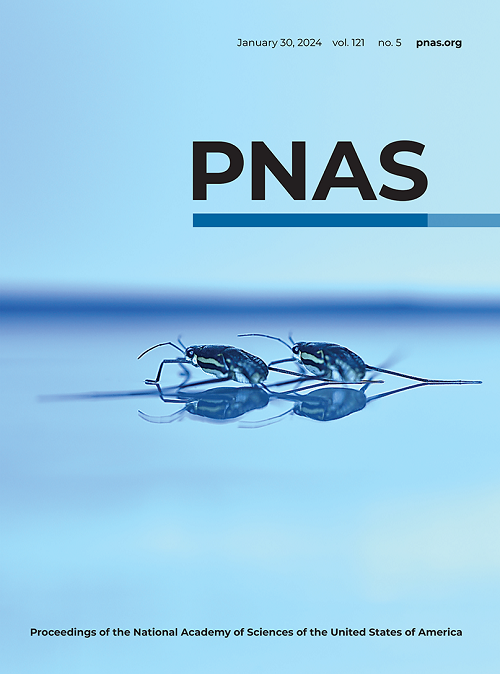大气氢浓度驱动ATP合成。
IF 9.4
1区 综合性期刊
Q1 MULTIDISCIPLINARY SCIENCES
Proceedings of the National Academy of Sciences of the United States of America
Pub Date : 2025-07-24
DOI:10.1073/pnas.2506353122
引用次数: 0
摘要
所有细胞都需要持续供应通用能量货币——三磷酸腺苷(ATP),以驱动无数细胞反应。普遍保守的F1Fo-ATP合成酶利用跨膜电化学质子梯度(pmf)从ADP和Pi中再生ATP。细菌已经进化出了多种利用光、有机和无机能源形成pmf的策略。最近,我们提出,在其他能源有限的情况下,许多细菌可以利用大气中的微量气体来产生ATP。然而,直接证据表明,大气能量来源足以产生的pmf驱动ATP合成仍然缺乏。在这里,我们展示了耻垢分枝杆菌膜相关的氢:醌氧化还原酶Huc可以从空气中合成ATP。纯化的Huc偶联H2氧化还原各种泛醌和甲基萘醌类似物。我们设计了一个最小的呼吸链,其中Huc与脂质体相互作用,脂质体含有来自大肠杆菌的非泵送但产生pmf的bd-I氧化酶和F1Fo-ATP合成酶。我们的实验表明,从空气到溶液的被动氢交换足以进行电子转移和积累ATP所需的pmf生成。通过将连续培养生物能量测量与理论计算相结合,我们发现这一过程足以使分枝杆菌维持pmf和ATP合成(每个H2氧化两个ATP分子),以维持营养饥饿期间的能量需求。这些发现证实,大气能源可以作为可靠的“生命线”基质,在营养匮乏期间实现持续的能量节约。此外,这项工作为合成应用中的ATP生产提供了一种独特的工具,与其他方法不同,它没有副产品积累,没有痕迹。本文章由计算机程序翻译,如有差异,请以英文原文为准。
ATP synthesis driven by atmospheric hydrogen concentrations.
All cells require a continuous supply of the universal energy currency, adenosine triphosphate (ATP), to drive countless cellular reactions. The universally conserved F1Fo-ATP synthase regenerates ATP from ADP and Pi by harnessing a transmembrane electrochemical proton gradient (pmf). Bacteria have evolved diverse pmf-forming strategies using light, organic, and inorganic energy sources. Recently, we proposed that many bacteria survive using atmospheric trace gases to produce ATP when limited for other energy sources. However, direct evidence that atmospheric energy sources are sufficient to generate pmf or drive ATP synthesis is still lacking. Here, we show that the membrane-associated hydrogen:quinone oxidoreductase Huc from Mycobacterium smegmatis can enable ATP synthesis from air. Purified Huc couples H2 oxidation to the reduction of various ubiquinone and menaquinone analogues. We designed a minimal respiratory chain in which Huc interacts with liposomes containing the nonpumping, but pmf-generating, bd-I oxidase and F1Fo-ATP synthase from Escherichia coli. Our experiments show that passive hydrogen exchange from air to solution is sufficient for the electron transfer and pmf generation required to accumulate ATP. By combining continuous culture bioenergetics measurements with theoretical calculations, we show this process is sufficient for mycobacteria to sustain pmf and ATP synthesis (two ATP molecules per H2 oxidized) for maintenance energy requirements during nutrient starvation. These findings confirm that atmospheric energy sources can be dependable 'lifeline' substrates that enable continuous energy conservation during nutrient starvation. In addition, this work provides a unique tool for ATP production in synthetic applications, which unlike other approaches is traceless without by-product accumulation.
求助全文
通过发布文献求助,成功后即可免费获取论文全文。
去求助
来源期刊
CiteScore
19.00
自引率
0.90%
发文量
3575
审稿时长
2.5 months
期刊介绍:
The Proceedings of the National Academy of Sciences (PNAS), a peer-reviewed journal of the National Academy of Sciences (NAS), serves as an authoritative source for high-impact, original research across the biological, physical, and social sciences. With a global scope, the journal welcomes submissions from researchers worldwide, making it an inclusive platform for advancing scientific knowledge.

 求助内容:
求助内容: 应助结果提醒方式:
应助结果提醒方式:


